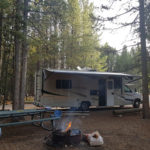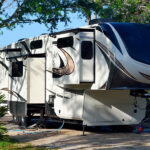Last updated: 29 Apr 2023

Awnings are an essential addition to any motorhome, providing shade and protection to travelers. However, they require regular maintenance to stay functional, as they can collect dust and water over time.
To prevent mold from forming on an awning, it’s essential that it be cleaned regularly. Mold can damage the structural components of an awning as it spreads through crevices in the fabric.
In addition, condensation on an awning causes corrosion on metal parts such as brackets; corrosion then makes these metal parts unsafe to touch. But before getting into deep details first let’s find out what things you need to remove mold from the RV awning.
What Will You Need?
As you may already know, the RV awning is one of the most exposed parts of your RV. When you set up camp, the awning will face the sun, wind, and rain throughout the day, making it vulnerable to damage and wear.
UV rays from the sun can break down awning fabric and cause it to deteriorate faster than what would normally happen. Wind can also cause damage as it blows dirt and other particles onto your roof. This accumulation of dirt on the roof can lead to mold growth on your RV awning.
When you own an RV, an awning is essential to protect the roof from the sun. But, it also needs care and attention in order to prevent corrosion, dirt and mold.
Materials you need for treating RV awnings are:
- White vinegar or Special RV awning cleaner
- A bucket or spray bottle (with soap)
- Cloth or sponge (to use with the bucket or spray bottle)
- An old toothbrush (for scrubbing)
- Lemon rinds or orange peels (to put in the bucket of vinegar solution)
- Water repellent fabric treatment that can be found at any hardware store
How to Remove Mold from an RV Awning
If you discover mold on your RV awning, there are steps you can take to effectively remove it. We would like to express our gratitude to “Camper Size Living” for providing a helpful video demonstration on this process.
Use Diluted Bleach
Make sure the awning is completely clean and dry before using any kind of bleach solution on it. Then, using a cheap spray bottle, apply a solution consisting of water and bleach that has been diluted to the area of your RV’s awnings that has been damaged (do not use dish soap).
Use Soft Brush or Sponge to Scrub the Mold
After waiting 10 minutes, give the area a thorough scrubbing with a gentle brush or sponge to eradicate any mold that may still be present. To eliminate any remaining mold residue, either spray the area with water mixed with vinegar or use a towel that has been soaked in vinegar and water solution to wipe clean the area. Scrub the mold away with a gentle brush, and then wash to remove the bleach and finish cleaning the surface.
Use Spray to Remove the Remaining Stains
Sprays that are already on the market can also be used to remove stains that refuse to disappear. Even though they may have more potentially harmful ingredients, they are nonetheless effective when the situation calls for them.
After removing the unattractive black dots, you can use your camper van’s ventilation system, assuming it has sufficient circulation, to dry the areas that are still wet.
Safety Precautions
To keep yourself and others safe, only use chemicals that are approved for use. Don’t risk injury by not using safety gear like gloves and eye protection.
FAQ
Can I Use Pressure to Remove the Awning?
A pressure washer can be used to clean an RV awning, but it should be handled with utmost caution to avoid harm. The damaging power of a pressure washer is extremely harmful to vinyl awnings. Check if a water hose won’t do the task before breaking out the power washer.
How Do You Keep Water From Pooling on an RV Awning?
One way to keep water from pooling on your awning is to make sure that it’s properly angled. Most awnings have adjustable legs that you can use to change the angle. By angling the awning, you’ll allow water to run off more easily.
Another way to prevent water pooling is to use an awning cover. Awning covers provide an extra layer of protection from the elements and can help keep your awning dry.
Conclusion
RV and trailer awnings are crucial for providing shade and protection from the elements while camping. However, because they are constantly exposed to the elements, awnings can collect dust and moisture, which require regular maintenance to keep them clean and in good condition. If you notice mold growing on your awning, it’s important to remove it promptly to prevent it from spreading and becoming more difficult to remove. In this article, we’ll provide steps for safely and effectively removing mold from your RV or trailer awning.
It’s best to clean the fabric thoroughly and scrub it to remove all the mold spores and debris. So, it’s the end of the process of removing a mold from the RV awning. If you find this tutorial informative and helpful then feel free to comment your precious words in the comment box. It will be a great pleasure for me.
Related Review:



